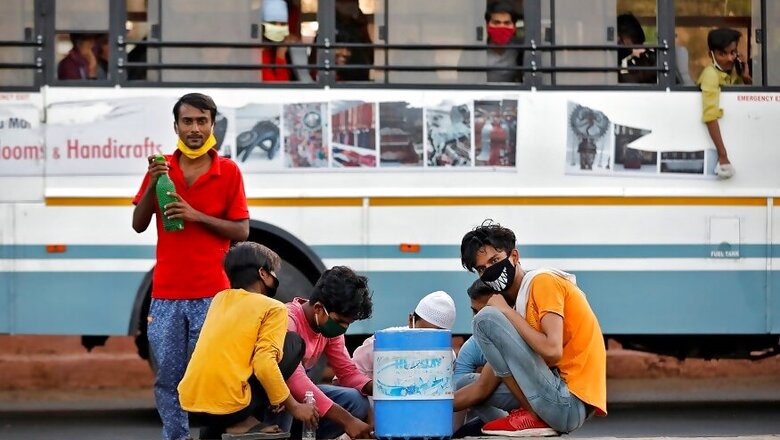
views
The state of Bihar is on the brink of witnessing overlapping hazards. The number of COVID-19 affected cases in the state is on the rise and it will shortly move into those months where a large part of the state -- entire north Bihar, five districts of South Bihar, and one district that spreads across both the regions -- are exposed to the risk of floods. There is urgent requirement on the part of the state -- along with the non-state actors -- to take immediate measures towards acknowledging the multiple risk that emanate from these overlapping hazards and reducing of the same.
Collective action of state and non-state actors at the ward level is needed to develop co-benefit strategies -- actions that would help people to minimise the impact of floods, but in a manner that also restricts the spread of the coronavirus. The key action points that needs to be taken include a ward-level disaster management plan, large scale construction of elevated platforms through Mahatma Gandhi National Rural Employment Guarantee Act (MGNREGA), universal access to safe water and sanitation facility, and all these while strictly adhering to the COVID-norms of physical distancing and use to PPEs.
All the 38 districts of Bihar have reported COVID-19 cases and the numbers have been increasing every day. On May 24, there were 180 new cases, taking the total number of confirmed cases in the state to 2,574. Many of these districts are prone to urban flooding, flash floods and riverine floods. (North) Bihar and floods are synonymous. As recent as last year, some 12 million people were affected from floods. Going by the report of Bihar State Disaster Management Authority (BSDMA), during 2008-2016 a total of 629 blocks, around 27 million people and some 11 million hectares of agriculture land got affected from floods.
Flood months bring with themselves a typology of hazards associated with the geographical location of habitation and have differential effects. The typologies include: waterlogged regions, areas which are in the riverside and prone to bank erosion, riverine floods in areas with no embankment, riverine floods in the countryside after the breach of the embankment, flash floods in riverside of embankments, flash floods in regions without embankments and waterlogging in regions between embankments of two river system. While the pandemic might not discriminate across locations, the effect across the typologies would be different. Hence, any action aimed towards reducing vulnerability, should first acknowledge the existence of the typologies.
In the coming weeks, the state and non-state actors should collectively endeavour towards developing a ward level plan through engagements with the residents for enhancing the preparedness. The plan needs to have strategies geared towards enhanced access to basic amenities, in sync with the norms for containment of the corona virus. Women, senior citizen and children are the most vulnerable under stress situation, and the ward level plan should particularly be sensitive to the needs of these group.
One important activity to be undertaken at the ward level is the identification of spaces for construction of elevated platforms that would act as flood shelters. This could be a challenge in a densely populated region like North Bihar. The usual shelters like schools or government buildings might already be occupied as quarantine centres. Construction of elevated platforms promoted through MGNREGA would have twin benefits: contribute in employment generation, apart from acting as shelter, before the flood strikes.
The plans have to be made keeping the physical distancing norms as mandated under COVID-19 guidelines coupled with access to safe drinking water and sanitation. Given the norms of for physical distancing, fewer people will have to be accommodated inside a shelter. Hence a greater number of shelter construction needs to be promoted aggressively. The platforms across different flood typologies post floods can be used as a diverse utility area (DUA) dependent on the ward-level requirements.
Awareness campaign at the ward level undertaken on corona pandemic should also highlight on the precautions to be undertaken during flood months. Groups at the ward levels need to be established who would shoulder diverse responsibilities with regard to flood preparedness. A decentralised surveillance committee at the ward levels formed to monitor the adherence of the containment norms, also needs to undertake regular monitoring of the nearest flood defence infrastructure (embankments) and drainage lines in order to stop clogging of the same.
The ward level plan needs to make advance planning on secured access to basic amenities like drinking water, sanitation and hygiene interventions. Field experiences are a testimony of the fact that alternative practices for safe drinking water, through temporary rainwater harvesting system and disaster resilient sanitation technology like eco-sanitation could be aggressively promoted to build resilience in the flood prone areas.
At the district level a revisit to the district disaster plan in view of the challenges brought in by the coronavirus pandemic and floods is mandatory. Safe approaches proportionate to the nature and intensity of floods, and in sync with the prescribed norms of corona containment needs to be a new normal for the state of Bihar.
(Eklavya Prasad works with Megh Pyne Abhiyan. Nirmalya Choudhury works with VikasAnvesh Foundation. Views are personal.)


















Comments
0 comment